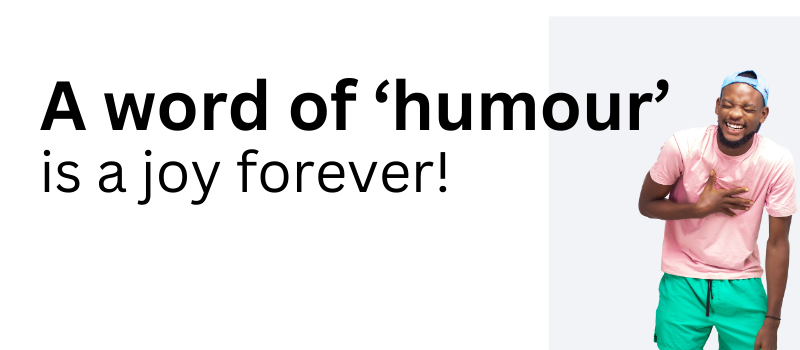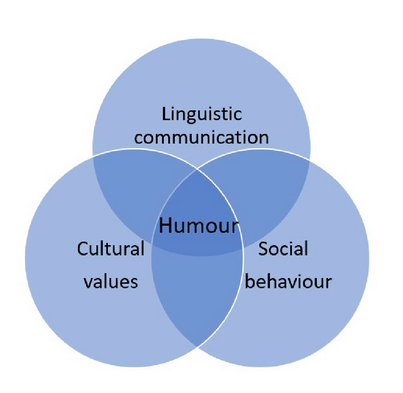- Home
- Public communication
- A word of ‘humour’ is a joy forever!
A word of 'humour' is a joy forever!

Can humour be a powerful communication tool?
We talk about effective communication as a practice that helps us articulate our messages to our intended audience, through appropriate channels, on time. We can also talk about the various Ps in the prescriptive marketing lingo, namely, product, price, place, and promotion.
However, what is the key element that allows our messages to leave an everlasting imprint on the audiences’ minds?
Why is it that memorable taglines, visuals, or advertisements such as “You’re Not You When You’re Hungry” (Snickers), “The Man Your Man Could Smell Like” (Old Spice), or “Dumb Ways to Die” (Metro Trains Melbourne) generate instant recall in the audiences’ mind?
Humour is the marketing panacea that does far more than just make people laugh. It functions as an effective icebreaker, connecting with the audience at an emotional level. It also creates a level of trust that encourages the audience to continue listening. The lighter tone goes a long way in supporting message retention.
Funny content wins viewers by engaging them for much longer, allowing them to reflect on the content, and possibly even impacting their mood. Any marketing content that can capture an audience’s attention for longer than a few seconds has already won half the battle of attracting potential new followers for the brand, business, or messages.
We may have forgotten the long-gone days of the dial-up internet, but I bet that most of you remember the Telstra Bigpond advertisement from 2005.
Yes, this was the advertisement that suggested that the Great Wall of China was built to keep the rabbits out (Emperor Nasi Goreng built the wall because there were too many rabbits in China!)
And why? Dare we say that it is the use of humour that keeps it fresh in our memory? And not just that, it triggers a sense of positive nostalgia, supporting strong brand recollection.
Humour sits at the intersection of linguistic communication, social behaviour, and cultural values. It is possibly at the heart of all elements of effective communication.

Diagram above from the article, Introduction: When language typology meets multilingualism. From languages to uses and people by Marco Gargiulo, Åsta Haukås and Iørn Korzen.
It is the positive emotion of humour that resonates with people, grabs their attention and aids in content absorption. Humour triggers an emotional reaction that can catalyse a behavioural response towards the intended stimulus. In many cases, it has proven to be effective for better retention, even in social advertising, where achieving behavioral change through communication can be particularly challenging.
The ‘Dumb Ways to Die’ advertisement developed by Metro Trains Melbourne surprised viewers with quirky examples of ignorant ways one could meet their end, accompanied by a catchy tune.
The light-hearted approach contrasted and supported the heavy, bleak, and often dull message of road safety. Further, it encouraged sharing on social media, creating a desirable word-of-mouth chain reaction. This was no easy feat especially considering that it was a community services message!
As rewarding as humorous communication can be, it comes with boundaries due to the risks posed by cultural sensitivities. Much can be lost in translation, and our efforts may backfire. Understanding your audience well is key, especially in a multicultural society.
It takes more than simply realising the difference between being ‘pissed’ in America (when someone is angry) and ‘pissed’ in the UK (which refers to being drunk).
Humour creates distinct mental images based on what the audience perceives from such content and this is heavily dependent on their values, culture, religion, morals, and to a large extent, their psychological conditioning. Therefore, this can present a significant challenge because what is intended may not necessarily evoke the same emotion or response from everyone.
The clothing brand, Lambs, claimed to block 99% of electromagnetic fields from cellphones, 4G, 5G, Wi-Fi or Bluetooth radion. Could their quirky and slightly over-the-top humourous promotion have worked if it was disseminated among a culturally traditional audience?
The new startup company, Lambs, used their partners, including the founder, as ‘underwear’ models in their advertisements. Additionally, the advertisements used quirky imagery that showcased how anti-wave underwear would safeguard a man’s sperm count as a way to promote the benefits of their product.
This antic not only turned their underwear shorts into a fun and attractive product within a few months of their launch but it catapulted their profits. Their advertisement demonstrated how humour can reap better rewards for health products than fear-mongering messages. If this looks intriguing, take a look at Balls… or succeeding thanks to humor in our startup marketing, a TEDxAgroParisTech talk by Arthur Menard.
The moral of the story is this: if humour is used sensibly, while keeping in mind decency and cultural boundaries, it can help build a long-term relationship with a profound tinge of positive nostalgia. Humour instantly grabs attention, leading to strong message recall and social sharing through various channels. In the current world, where the average consumer’s attention span is less than eight seconds, humour can effectively cut through the clutter.
When humour is executed correctly, it has the potential to yield significant returns. So, let’s embrace the power of ‘funny’ and carry on 😉 😊

Pallavi Singh is an integrated communication strategist and an IABC Canberra Board member.